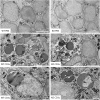Thymocyte development in the absence of matrix metalloproteinase-9/gelatinase B
- PMID: 27432536
- PMCID: PMC4949482
- DOI: 10.1038/srep29852
Thymocyte development in the absence of matrix metalloproteinase-9/gelatinase B
Abstract
Matrix metalloproteinases (MMP) play critical roles in a variety of immune reactions by facilitating cell migration, and affect cell communication by processing both cytokines and cell surface receptors. Based on published data indicating that MMP-9 is upregulated upon T cell activation and also in the thymus upon the induction of negative selection, we investigated the contribution of MMP-9 into mouse T cell development and differentiation in the thymus. Our data suggest that MMP-9 deficiency does not result in major abnormalities in the development of any conventionally selected or agonist selected subsets and does not interfere with thymocyte apoptosis and clearance, and that MMP-9 expression is not induced in immature T cells at any stage of their thymic development.
Figures







Similar articles
-
Matrix metalloproteinase-9 in macrophages induces thymic neovascularization following thymocyte apoptosis.J Immunol. 2005 Jan 15;174(2):846-53. doi: 10.4049/jimmunol.174.2.846. J Immunol. 2005. PMID: 15634906
-
CBAP promotes thymocyte negative selection by facilitating T-cell receptor proximal signaling.Cell Death Dis. 2014 Nov 13;5(11):e1518. doi: 10.1038/cddis.2014.474. Cell Death Dis. 2014. PMID: 25393474 Free PMC article.
-
Molecular mechanisms governing thymocyte migration: combined role of chemokines and extracellular matrix.J Leukoc Biol. 2004 Jun;75(6):951-61. doi: 10.1189/jlb.1003455. Epub 2004 Mar 12. J Leukoc Biol. 2004. PMID: 15020651 Review.
-
Autonomous and extrinsic regulation of thymopoiesis in human immune system (HIS) mice.Eur J Immunol. 2011 Oct;41(10):2883-93. doi: 10.1002/eji.201141586. Epub 2011 Aug 30. Eur J Immunol. 2011. PMID: 21739431
-
How to find your way through the thymus: a practical guide for aspiring T cells.Cell Mol Life Sci. 2012 Mar;69(5):663-82. doi: 10.1007/s00018-011-0791-6. Epub 2011 Aug 14. Cell Mol Life Sci. 2012. PMID: 21842411 Free PMC article. Review.
Cited by
-
Endotoxemia shifts neutrophils with TIMP-free gelatinase B/MMP-9 from bone marrow to the periphery and induces systematic upregulation of TIMP-1.Haematologica. 2017 Oct;102(10):1671-1682. doi: 10.3324/haematol.2017.168799. Epub 2017 Aug 3. Haematologica. 2017. PMID: 28775117 Free PMC article.
-
TL1A and IL-18 synergy promotes GM-CSF-dependent thymic granulopoiesis in mice.Cell Mol Immunol. 2024 Aug;21(8):807-825. doi: 10.1038/s41423-024-01180-8. Epub 2024 Jun 5. Cell Mol Immunol. 2024. PMID: 38839915 Free PMC article.
-
The thymus road to a T cell: migration, selection, and atrophy.Front Immunol. 2024 Aug 27;15:1443910. doi: 10.3389/fimmu.2024.1443910. eCollection 2024. Front Immunol. 2024. PMID: 39257583 Free PMC article. Review.
References
-
- Opdenakker G., Van den Steen P. E. & Van Damme J. Gelatinase B: a tuner and amplifier of immune functions. Trends Immunol 22, 571–579 (2001). - PubMed
Publication types
MeSH terms
Substances
LinkOut - more resources
Full Text Sources
Other Literature Sources
Miscellaneous

